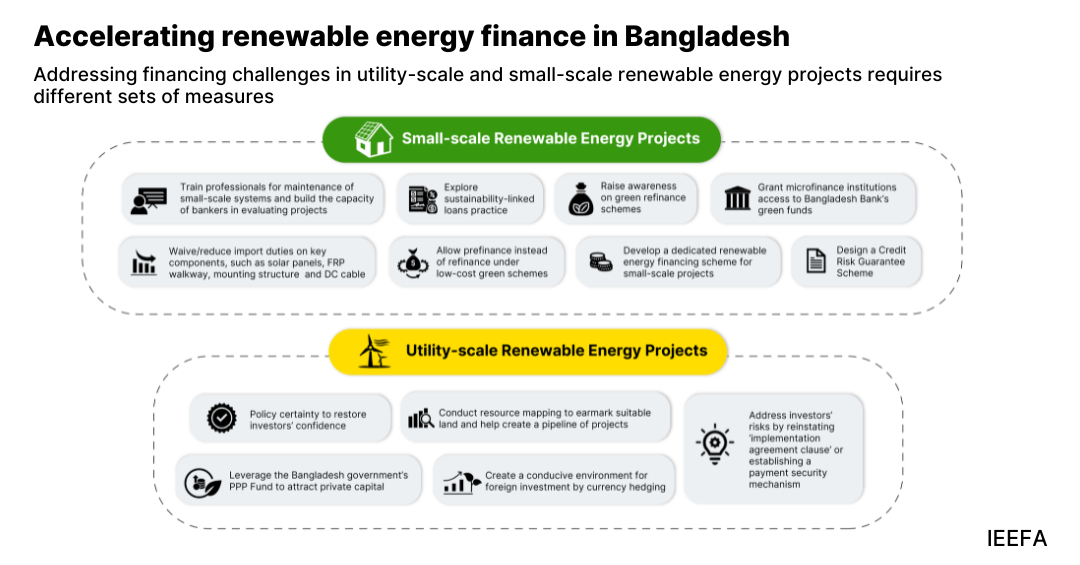
The country needs to create an enabling environment for investment in utility-scale and small-scale projects through streamlined policy and regulations.
Key takeaways:
-
Bangladesh will require up to US$980 million annually until 2030 to meet the goal set out in the Renewable Energy Policy 2025. Post-2030, the country will need up to US$1.46 billion annually until 2040.
-
Policy uncertainty, offtaker and currency risk, land acquisition challenges, and a downgraded sovereign rating limit capital flows into the renewable energy sector.
-
A credit risk guarantee scheme, a dedicated green finance facility with scope for pre-finance, and an import duty waiver on solar components can help accelerate the flow of finance for small-scale renewable energy projects.
-
The country needs to create an enabling environment for investment in utility-scale projects through streamlined policy and regulations.
IEEFA South Asia, June 25, 2025 (PR) - The Bangladesh government has set targets for generating 20% and 30% of electricity from renewable energy sources by 2030 and 2040, respectively, under the country’s new Renewable Energy Policy.
Bangladesh will require between US$933 million and US$980 million annually until 2030 to meet the new target. Post-2030, the country will need between US$1.37 billion and US$1.46 billion annually until 2040, a new report by the Institute of Energy Economics and Financial Analysis (IEEFA) finds.

“Public finance alone is unlikely to meet these funding requirements, necessitating large-scale private investment,” says the report’s co-author, Shafiqul Alam, IEEFA’s lead energy analyst for Bangladesh. However, abrupt policy changes, off-taker risk, technology and performance risk, weak project pipelines, a cumbersome loan disbursal process, land acquisition challenges, currency volatility, and lower sovereign rating limit private sector investment in the sector, Alam notes.
By engaging with Multilateral Development Banks, international climate finance institutions and bilateral development financial institutions, the government can consider establishing a currency hedging fund to mitigate currency risk.
The current government has suspended 31 utility-scale renewable energy projects that received Letters of Intent through the non-competitive bidding process under the previous government. This sudden shift to competitive bidding and the resulting contractual uncertainties have left investors feeling disconcerted. The report highlights that Bangladesh should ensure regulatory stability, restore investor guarantees, map and allocate land for projects, and build capacity in both the banking and service provider ecosystems to attract investment.
The report underscores the importance of reinstating the “project implementation clause” to dispel uncertainties over payment or establish a funding mechanism to provide revenue assurance to renewable energy producers, mitigating counterparty risks.
“Land acquisition challenges can be mitigated through the Public-Private Partnership model, which can help mobilise investment in renewable energy projects through special economic zones,” Alam suggests.
“In the case of small-scale renewable energy projects, their accelerated deployment will depend on addressing the high import duty on critical components, performance issues and perceived risks. Easing lending norms for green funds can also help scale up such projects,” says Labanya Prakash Jena, Sustainable Finance Consultant, IEEFA.
The report acknowledges the government’s positive move in reducing the customs duty on imported solar inverters and calls on the government to reduce the import duty on components of small-scale solar projects, such as solar panels, FRP walkway, mounting structure and DC cable. The report emphasizes the importance of adopting a pre-finance modality of the Central Bank’s green funds to minimize delays and simplify disbursement.
Bangladesh's low sovereign credit ratings also deter foreign investors. “Moody’s downgraded Bangladesh’s credit rating to B2 in November 2024 from B1 earlier, based on the country’s lower-than-expected economic growth in the near term, political challenges and banking sector risks. This has further deteriorated the country’s credit profile in the international financial market, making borrowing expensive,” notes Jena.
“The government, international organizations, financial institutions, private investors, and renewable energy companies should collaborate to create a conducive environment that fosters innovation, investment, and sustainable growth,” Alam emphasizes.
About IEEFA: The Institute for Energy Economics and Financial Analysis (IEEFA) examines issues related to energy markets, trends, and policies. The Institute’s mission is to accelerate the transition to a diverse, sustainable and profitable energy economy. (ieefa.org)



